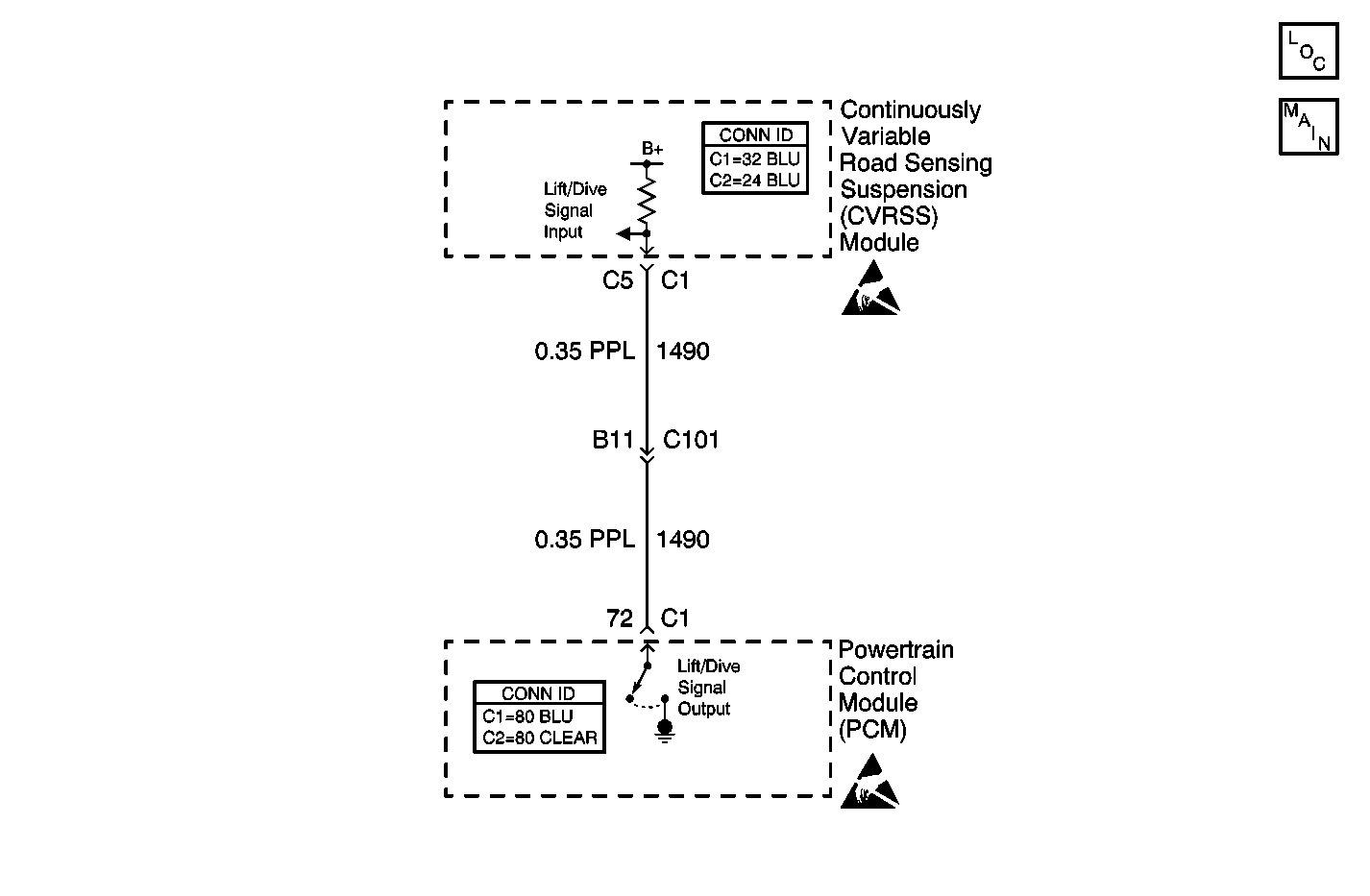
Circuit Description
The Electronic Suspension Control (ELC) module monitors a lift/dive signal at the Powertrain Control Module (PCM). Under normal conditions, the Electronic Suspension Control (ELC) module supplies a 12 volt reference voltage to the PCM. The PCM grounds this circuit when the vehicle is accelerating rapidly (LIFT) or braking hard (DIVE). When the lift/dive signal goes low (approximately 0 volts), the Electronic Suspension Control (ELC) module commands all four CVRSS dampers to a FIRM condition.
Conditions for Running the DTC
| • | The Ignition is on. |
| • | The fault is detected during three consecutive ignition cycles, or during the same ignition cycle after clearing the DTC with a scan tool. |
Conditions for Setting the DTC
The DTC is set when the Electronic Suspension Control (ELC) module does not sense the low-to-high transition on the lift/dive circuit within 31 seconds after the ignition is turned ON.
Action Taken When the DTC Sets
| • | The CVRSS lift/dive function will be disabled. |
| • | The vehicle will pitch more during a braking or wide open throttle condition. |
| • | The SERVICE RIDE CONTROL message will be displayed. |
Conditions for Clearing the MIL/DTC
| • | The scan tool can be used to clear the DTC. |
| • | The On-Board diagnostic CLEAR RSS CODES feature can be used to clear the DTC. |
| • | The DTC is saved as history when the Electronic Suspension Control (ELC) module sees the low-to-high transition on the lift/dive signal from the PCM during a valid test period. The DTC will clear if the fault does not return after 50 consecutive ignition cycles. |
Diagnostic Aids
As part of the vehicle diagnostic system, the PCM toggles the lift/dive line within 31 seconds after the ignition is turned ON. This allows the Electronic Suspension Control (ELC) module to determine if the line is faulted or not. A retry is attempted every four minutes until successful.
An intermittent short to ground or an open in the Lift/Dive Signal circuit may cause a random firm/soft ride condition.
Test Description
The number(s) below refer to the step number(s) on the diagnostic table.
-
This step tests for normal function of the PCM (inactive).
-
This step tests for normal function of the PCM (active).
-
This step tests for an intermittent or poor connection at the PCM.
-
This step tests for a short to ground in the Lift/Dive Signal circuit.
Step | Action | Value(s) | Yes | No |
|---|---|---|---|---|
1 | Did you perform the Road Sensing Suspension Diagnostic System Check? | -- | Go to Step 2 | Go to Diagnostic System Check |
Does the scan tool display inactive? | -- | Go to Step 3 | Go to Step 4 | |
Does the lift/dive data parameter change state? | -- | Go to Diagnostic Aids | Go to Step 4 | |
Does the scan tool display inactive? | -- | Go to Step 7 | Go to Step 5 | |
Test the signal circuit of the PCM for a short to ground. Refer to Circuit Testing and Wiring Repairs in Wiring Systems. Did you find and correct the condition? | -- | Go to Step 10 | Go to Step 6 | |
6 | Inspect for poor connections at the harness connector of the Electronic Suspension Control (ELC) module. Refer to Testing for Intermittent Conditions and Poor Connections and Connector Repairs in Wiring Systems. Did you find and correct the condition? | -- | Go to Step 10 | Go to Step 8 |
7 | Inspect for poor connections at the harness connector of the PCM. Refer to Testing for Intermittent Conditions and Poor Connections and Connector Repairs in Wiring Systems. Did you find and correct the condition? | -- | Go to Step 10 | Go to Step 9 |
8 |
Important: Perform the set up procedure for the Electronic Suspension Control (ELC) module. Replace the Electronic Suspension Control (ELC) module. Refer to Electronic Suspension Control Module Replacement . Did you complete the replacement? | -- | Go to Step 10 | -- |
9 | Replace the PCM. Refer to Powertrain Control Module Replacement/Programming . Did you complete the replacement? | -- | Go to Step 10 | -- |
10 |
Does the DTC reset? | -- | Go to Step 2 | System OK |
